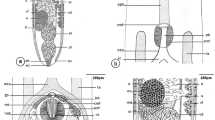Abstract
A detailed study of the surface topography of the echinostome digenean Mesorchis denticulatus (Rudolphi 1802) Dietz 1909 was carried out using the scanning electron microscope. The surface area of the redia is increased by microvilli, and ciliate sensory structures are common around the mouth. The cannibalistic behaviour of the rediae is demonstrated by rediae which have the posterior end and tail of extraredial cercariae protruding from the mouth. The partly devoured cercariae had occasionally — apparently as a defence reaction — covered their bodies with a thick layer of cystogenous material, which, however, does not protect them from being eaten.
The surface area of the tegument of the youngest extraredial cercariae is increased by small microvilli or knobs with a presumed function in nutrient absorption. The knobs disappear when the cercariae are fully developed. Flattened spines occur peripherally in the suckers. Different types of ciliate structures are especially common anteriorly. The infective metacercariae, which occur in the gill filaments of euryhaline fishes, have conspicuous collar spines and smaller pointed spines occur on most of the body surface.
The spines continue to grow in the experimental final host, chickens. The flattened spines of the oral sucker remain, whereas those of the ventral sucker disappear. The ventral area between the suckers is spineless.
Similar content being viewed by others
References
Chapman HD, Wilson RA (1970) The distribution and fine structure of the integumentary papillae of the cercaria of Himasthla secunda (Nicoll). Parasitology 61:219–227
Combes C (1982) Trematodes: antagonism between species and sterilizing effects on snails in biological control. Parasitology 84(4):151–175
Fried B, Fujino T (1984) Scanning electron microscopy of Echinostoma revolutum (Trematoda) during development in the chick embryo and the domestic chick. Int J Parasitol 14:75–81
Hoskin GP (1975) Light and electron microscopy of the hostparasite interface and histopathology of Nassarius obsoletus infected with rediae of Himasthla quissetensis. Ann NY Acad Sci 266:497–512
Irwin SWB, McKerr G, Judge BC, Moran I (1984) Studies on metacercarial excystment in Himasthla leptosoma (Trematoda: Echinostomatidae) and newly emerged metacercariae. Int J Parasitol 14:415–421
Køie M (1985) On the morphology and life-history of Lepidapedon elongatum (Lebour, 1908) Nicoll, 1910 (Trematoda, Lepocreadiidae). Ophelia 24:135–153
Køie M (1986) The life-history of Mesorchis denticulatus (Rudolphi, 1802) Dietz, 1909 (Trematoda, Echinostomatidae). Z Parasitenkd 72:335–343
Lim HK, Heyneman D (1972) Intramolluscan inter-trematode antagonism: a review of factors influencing the host-parasite system and its possible role in biological control. Adv Parasitol 10:191–268
Smales LR, Blankespoor HD (1984) Echinostoma revolutum (Froelich, 1802) Looss, 1899 and Isthmiophora melis (Schrank, 1788) Lühe, 1909 (Echinostomatinae, Digenea): Scanning electron microscopy of the tegumental surfaces. J Helminthol 58:187–195
Author information
Authors and Affiliations
Rights and permissions
About this article
Cite this article
Køie, M. Scanning electron microscopy of rediae, cercariae, metacercariae and adults of Mesorchis denticulatus (Rudolphi, 1802) (Trematoda, Echinostomatidae). Parasitol Res 73, 50–56 (1987). https://doi.org/10.1007/BF00536336
Accepted:
Issue Date:
DOI: https://doi.org/10.1007/BF00536336




